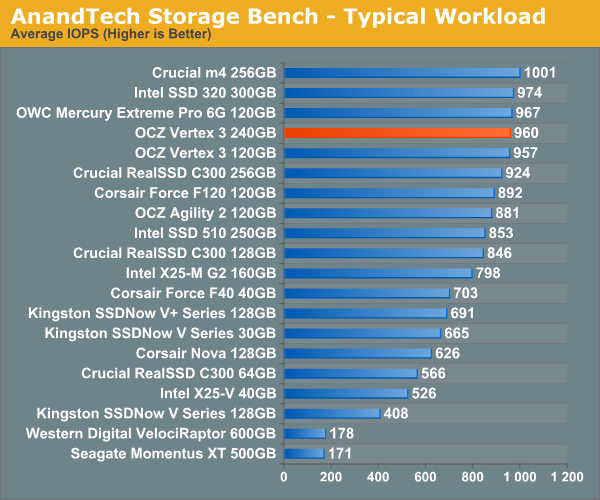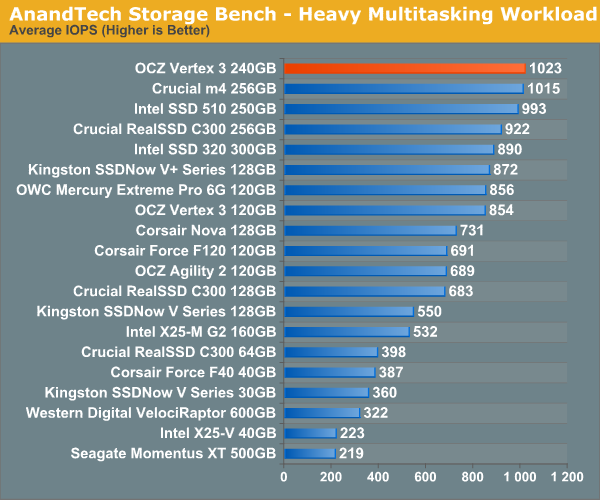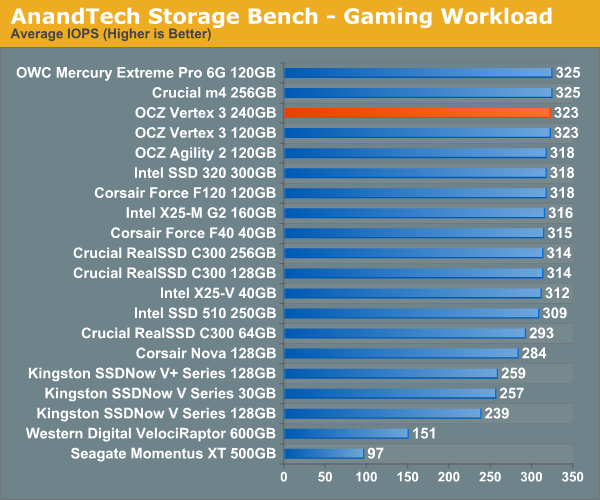OCZ Vertex 3 (240GB) Review
by Anand Lal Shimpi on May 6, 2011 1:50 AM ESTAnandTech Storage Bench 2010
To keep things consistent we've also included our older Storage Bench. Note that the old storage test system doesn't have a SATA 6Gbps controller, so we only have one result for the 6Gbps drives.
The first in our benchmark suite is a light/typical usage case. The Windows 7 system is loaded with Firefox, Office 2007 and Adobe Reader among other applications. With Firefox we browse web pages like Facebook, AnandTech, Digg and other sites. Outlook is also running and we use it to check emails, create and send a message with a PDF attachment. Adobe Reader is used to view some PDFs. Excel 2007 is used to create a spreadsheet, graphs and save the document. The same goes for Word 2007. We open and step through a presentation in PowerPoint 2007 received as an email attachment before saving it to the desktop. Finally we watch a bit of a Firefly episode in Windows Media Player 11.
There’s some level of multitasking going on here but it’s not unreasonable by any means. Generally the application tasks proceed linearly, with the exception of things like web browsing which may happen in between one of the other tasks.
The recording is played back on all of our drives here today. Remember that we’re isolating disk performance, all we’re doing is playing back every single disk access that happened in that ~5 minute period of usage. The light workload is composed of 37,501 reads and 20,268 writes. Over 30% of the IOs are 4KB, 11% are 16KB, 22% are 32KB and approximately 13% are 64KB in size. Less than 30% of the operations are absolutely sequential in nature. Average queue depth is 6.09 IOs.
The performance results are reported in average I/O Operations per Second (IOPS):

If there’s a light usage case there’s bound to be a heavy one. In this test we have Microsoft Security Essentials running in the background with real time virus scanning enabled. We also perform a quick scan in the middle of the test. Firefox, Outlook, Excel, Word and Powerpoint are all used the same as they were in the light test. We add Photoshop CS4 to the mix, opening a bunch of 12MP images, editing them, then saving them as highly compressed JPGs for web publishing. Windows 7’s picture viewer is used to view a bunch of pictures on the hard drive. We use 7-zip to create and extract .7z archives. Downloading is also prominently featured in our heavy test; we download large files from the Internet during portions of the benchmark, as well as use uTorrent to grab a couple of torrents. Some of the applications in use are installed during the benchmark, Windows updates are also installed. Towards the end of the test we launch World of Warcraft, play for a few minutes, then delete the folder. This test also takes into account all of the disk accesses that happen while the OS is booting.
The benchmark is 22 minutes long and it consists of 128,895 read operations and 72,411 write operations. Roughly 44% of all IOs were sequential. Approximately 30% of all accesses were 4KB in size, 12% were 16KB in size, 14% were 32KB and 20% were 64KB. Average queue depth was 3.59.

The gaming workload is made up of 75,206 read operations and only 4,592 write operations. Only 20% of the accesses are 4KB in size, nearly 40% are 64KB and 20% are 32KB. A whopping 69% of the IOs are sequential, meaning this is predominantly a sequential read benchmark. The average queue depth is 7.76 IOs.











90 Comments
View All Comments
dagamer34 - Friday, May 6, 2011 - link
Great review Anand, but a far more practical question is this, why should the average consumer get the OCZ Vertex 3 at a almost $100 street price premium when the Vertex 2 performs reasonably well in all areas that matter? Almost no regular consumer is actually going to benefit from having sustained 500MB/sec read/writes compared to 200MB/sec because you'd actually need a source/destination that can also dish out or take in data that fast. Sure, compared to a HDD, any SSD is better, but is for example loading Windows in 14 seconds as opposed to 9 seconds really worth that much.Of course, for business markets, all bets are off and faster is almost always better since they've got RAID arrays churning to get data access as fast as possible. One SSD can easily replace a RAID 5 Raptor array at a far lower cost.
Anand Lal Shimpi - Friday, May 6, 2011 - link
I think for the average consumer simply making the move to an SSD is good enough. From there it's a question of subtlety. I can notice the difference on a Sandy Bridge system between a Vertex 2 and Vertex 3 - is it worth the price premium? For most users I'd say no, particularly if you aren't running a platform with a good 6Gbps controller.Take care,
Anand
aegisofrime - Friday, May 6, 2011 - link
Thanks for the answer, I was wondering the same thing as well. With Vertex 2s going for cheap nowadays, I think I can settle for a Vertex 2. Thanks for all the great work Anand, Anandtech is the first site I hit when I wake up :)vol7ron - Friday, May 6, 2011 - link
It's good advice, but also keep in mind scalability and future-proofing.How long do you keep your HDs? I keep mine until failure. Even if I don't have enough SATA ports on my mobo/cards, I'll use USB transformers to make user of the drives.
How important is it to you to buy an inferior product? To most users, it might not matter and the others might not care; but keep in mind you might use it as an external drive some day and you might want it to be able to saturate, or at least make use of the bandwidth for that external interface - think USB3/4 or Light Peak (Thunderbolt).
That being said, "deals" are deals for a reason and there's no such thing as a bad deal, just "mistakes" and "favors."
Rasterman - Monday, May 9, 2011 - link
That doesn't make any sense, drives can last for 10 years or more, are you really telling me you have a 50MB drive from 10 years ago that you have hooked up to a USB port sucking 10-20W down? At some point it makes more sense to consolidate and upgrade, its only a matter of time before the cost to simply power the drive isn't worth the money. Add to that error rates increase exponentially as the drive ages and your data will simply not be reliable.I personally get a new storage drive every 3-4 years, the old ones are re-purposed into encrypted off-site backups as they usually aren't worth anything used.
jharmon - Friday, May 6, 2011 - link
Again Anand, thank you so much for an excellent review. However, I was wondering if you could expound a bit more on this comment. I am currently running the X58 with Marvell 9128 controller. It is a sata 6Gbps interfaces, but the max bandwidth on that is 500 MB/s and it seems to be capping performance. Even OCZ warns about this on their website.You say you notice a different on SandyBrige, but what about the X58 platform?
Thanks again!
vol7ron - Friday, May 6, 2011 - link
These kinds of questions should go to the forum. Though authors/owners, do respond to some comments, the "Comments" section is not for questions, especially questions of another technology. I think they are meant for readers and users to leave comments on the article, content, or food-for-thought.v8x - Monday, May 9, 2011 - link
I do not agree, Who are you to decide what goes into the forums and what not? If Anand makes a statement in an article he wrote, it's not more than natural that questions on that statement go in the comments section.It is not a question on another technology, it's a question on a statement Anand made.
Hargak - Friday, May 6, 2011 - link
Actually, your RAM is usually the secondary device in 99% of the situations. And your RAM can receive data much faster than transferring it to another Vertex 3. Hence the improvements in loading large programs such as photoshop or big gaming programs. Whenever it is loading something you are taking data from the hard drive and caching it to RAM so the CPU can work with it in a much lower latency higher bandwidth situation. Then again, the question is whether or not the data is compressable. If it isn't then your basically back to Vertex 2 speeds. I'm also assuming in RAID 0 situations you would have a large margin of read bandwidth depending on the type of data compressable or uncompressable. I've been sold on SSD's since I found out that I could actually overclock the drive. I suggested to one of the engineers (Tony) hat they sell an overclocked version since there is headroom in added frequency. I overclocked the southbridge which made ~10% increase in performance on an old Core SSD. Down the road we may see performance SSD's possibly in card format with heatsinks and fans on them.Hargak - Friday, May 6, 2011 - link
Forgot to mention, that's how they came up with the Vertex Turbo, ;)